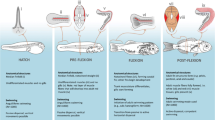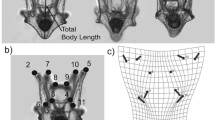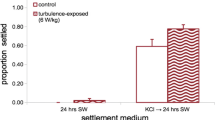Abstract
Aquatic organisms physically interact with the water that surrounds them, and this interaction is fundamental in shaping many aspects of their biology. General characteristics of the hydrodynamic interactions between organisms and the flow around them can be captured by the dimensionless Reynolds number (Re), depicting the ratio between inertial and viscous forces operating on the organism. The characteristic flow regime of larval fish that cruise at slow speeds is a regime of low Re, where viscous forces dominate. In this study, we experimentally test the ‘safe harbour’ hypothesis, which proposes that increasing larval body size facilitates an ‘escape’ from the detrimental effects of low Re. Larval gilthead seabream (Sparus aurata) were reared during early ontogeny under artificially manipulated water viscosities to expose larvae to low Re regimes. Larval survival decreased significantly with increasing water viscosity, and increased with increasing standard length. Surviving larvae exceeded the mean length of mortalities by ~1 mm, on average. Our findings provide direct experimental support for the ‘safe harbour’ hypothesis, indicating that marine larvae incur a fitness cost when operating under low Re conditions. Moreover, the results highlight the need to recognize the hydrodynamic environment when considering the a-biotic characteristics that may influence organismal performance and fitness.



Similar content being viewed by others
References
Abramoff MD, Magalhaes PJ, Ram SJ (2004) Image processing with ImageJ. Biol Med Phys Biomed 11:36–42
Amari T, Nakamura M (1973) Flow properties of aqueous solution of methylcellulose. J Appl Polym Sci 17:3439–3456
Aya FA, Corpuz MNC, García LMB (2015) Diet composition, feed preferences and mouth morphology of early stage silver therapon (Leiopotherapon plumbeus, Kner 1864) larvae reared in outdoor tanks. J Appl Ichthyol 31:77–82
Blake RW (2004) Fish functional design and swimming performance. J Fish Biol 65:1193–1222
China V, Holzman R (2014) Hydrodynamic starvation in first-feeding larval fishes. Proc Natl Acad Sci USA 111:8083–8088
China V, Levi L, Elmaliach T, Liberzon A, Holzman R (2017) Hydrodynamic regime affects feeding success and encounter rates with prey to determine feeding rates of larval fish during the critical period. Proc R Soc B Biol Sci 284:20170235. https://doi.org//10.1098/rspb.2017.0235
Cowles TJ, Strickler JR (1983) Characterization of feeding activity patterns in the planktonic copepod Centropages typicus Kroyer under various food conditions. Limnol Oceanogr 28:106–115
Danos N, Lauder GV (2012) Challenging zebrafish escape responses by increasing water viscosity. J Exp Biol 215:1854–1862
D’Alessandro EK, Sponaugle S, Cowen RK (2013) Selective mortality during the larval and juvenile stages of snappers (Lutjanidae) and great barracuda Sphyraena barracuda. Mar Ecol Prog Ser 474:227–242
Day SW, Higham TE, Holzman R, Van Wassenbergh S (2015) Morphology, kinematics, and dynamics: the mechanics of suction feeding in fishes. Integr Comp Biol 55:21–35
Drucker EG, Lauder GV (2000) A hydrodynamic analysis of fish swimming speed: wake structure and locomotor force in slow and fast labriform swimmers. J Exp Biol 203:2379–2393
Fuiman LA, Rose KA, Cowan JH, Smith EP (2006) Survival skills required for predator evasion by fish larvae and their relation to laboratory measures of performance. Anim Behav 71:1389–1399
Fyhn HJ (1989) First feeding of marine fish larvae: are free amino acids the source of energy? Aquaculture 80:111–120
Glasby TM (2001) Development of sessile marine assemblages on fixed versus moving substrata. Mar Ecol Prog Ser 215:37–47
Gorsky D, Zydlewski J (2013) Experimental evaluation of size-dependent predation by adult post-spawned rainbow smelt on larval lake whitefish. North Am J Fish Manag 33:163–169
Herbing I (2002) Effects of temperature on larval fish swimming performance: the importance of physics to physiology. J Fish Biol 61:865–876
Hernandez LP (2000) Intraspecific scaling of feeding mechanics in an ontogenetic series of zebrafish, Danio rerio. J Exp Biol 203:3033–3043
Holzman R, China V, Yaniv S, Zilka M (2015) Hydrodynamic constraints of suction feeding in low Reynolds numbers, and the critical period of larval fishes. Integr Comp Biol 55:48–61
Houde ED (1989) Comparative growth, mortality, and energetics of marine fish larvae: temperature and implied latitudinal effects. Fish B NOAA 87:471–495
Kaufmann A, Mickoleit M, Weber M, Huisken J (2012) Multilayer mounting enables long-term imaging of zebrafish development in a light sheet microscope. Development 139:3242–3247
Kiørboe T, Jiang H, Gonçalves RJ, Nielsen LT, Wadhwa N (2014) Flow disturbances generated by feeding and swimming zooplankton. Proc Natl Acad Sci USA 111:11738–11743
Koehl MAR, Strickler JR (1981) Copepod feeding currents: food capture at low Reynolds number. Limnol Oceanogr 26:1062–1073
Lauder GV (1980) Hydrodynamics of prey capture in teleost fishes. In: Schenck D (ed) Biofluid mechanics, vol II. Plenum, New York, pp 161–181
Mass T, Genin A, Shavit U, Grinstein M, Tchernov D (2010) Flow enhances photosynthesis in marine benthic autotrophs by increasing the efflux of oxygen from the organism to the water. Proc Natl Acad Sci USA 107:2527–2531
May RC (1974) Larval mortality in marine fishes and the critical period concept. In: Blaxter JHS (ed) The early life history of fish. Springer, Berlin, pp 3–19
McCoy MW, Bolker BM, Osenberg CW, Miner BG, Vonesh JR (2006) Size correction: comparing morphological traits among populations and environments. Oecologia 148:547–554
Müller UK, Videler JJ (1996) Inertia as a ‘safe harbour’: Do fish larvae increase length growth to escape viscous drag? Rev Fish Biol Fish 6:353–360
Müller UK, Stamhuis EJ, Videler JJ (2000) Hydrodynamics of unsteady fish swimming and the effects of body size: comparing the flow fields of fish larvae and adults. J Exp Biol 203:193–206
Osse JWM, Van den Boogaart JGM (1995) Fish larvae, development, allometric growth, and the aquatic environment. ICES Mar Sci Symp 201:21–34
Parra G, Yúfera M (2000) Feeding, physiology and growth responses in first-feeding gilthead seabream (Sparus aurata L.) larvae in relation to prey density. J Exp Mar Biol Ecol 243:1–15
Purcell EM (1977) Life at low Reynolds number. Am J Phys 45:3–11
R Development Core Team (2015) R: A language and environment for statistical computing. R Foundation for Statistical Computing, Vienna
Ruzicka JJ, Gallager SM (2006) The importance of the cost of swimming to the foraging behavior and ecology of larval cod (Gadus morhua) on Georges Bank. Deep Sea Res Part II 53:2708–2734
Shine R (1978) Propagule size and parental care: the “safe harbor” hypothesis. J Theor Biol 75:417–424
Simensen LM, Jonassen TM, Imsland AK, Stefansson SO (2000) Photoperiod regulation of growth of juvenile Atlantic halibut (Hippoglossus hippoglossus L.). Aquaculture 190:119–128
Tollrian R, Harvell CD (1999) The ecology and evolution of inducible defenses. Princeton University Press, Princton
van Duren LA, Videler JJ (2003) Escape from viscosity: the kinematics and hydrodynamics of copepod foraging and escape swimming. J Exp Biol 206:269–279
Villamizar N, Blanco-Vives B, Migaud H, Davie A, Carboni S, Sanchez-Vazquez FJ (2011) Effects of light during early larval development of some aquacultured teleosts: a review. Aquaculture 315:86–94
Vogel S (1994) Life in moving fluids. Princeton Univ Press, Princton
Wainwright PC, Day SW (2007) The forces exerted by aquatic suction feeders on their prey. J R Soc Interface 4:553–560
Webb PW (1984) Form and function in fish swimming. Sci Am 251:72–82
Webb PW, Weihs D (1986a) Functional locomotor morphology of early life history stages of fishes. Trans Am Fish Soc 115(115):127
Webb PW, Weihs D (1986b) Functional locomotor morphology of early life history stages of fishes. Trans Am Fish Soc 115(115):127
Westerfield M (2007) The Zebrafish book: a guide for the laboratory use of zebrafish (Danio rerio). University of Oregon Press, Eugene
Wood S (2006) Generalized additive models: an introduction with R. CRC Press, Boca Raton
Yaniv S, Elad D, Holzman R (2014) Suction feeding across fish life stages: flow dynamics from larvae to adults and implications for prey capture. J Exp Biol 217:3748–3757
Yaseen EI, Herald TJ, Aramouni FM, Alavi S (2005) Rheological properties of selected gum solutions. Food Res Int 38:111–119
Yavno S, Fox MG (2014) Morphological plasticity of native and non-native pumpkinseed sunfish in response to habitat type. Evol Ecol Res 16:373–395
Yavno S, Fox MG, Vila-Gispert A, Bhagat Y (2013) Morphological differences between native and non-native pumpkinseed in traits associated with locomotion. Environ Biol Fish 96:507–518
Yen J (2000) Life in transition: balancing inertial and viscous forces by planktonic copepods. Biol Bull 198:213–224
Acknowledgements
We thank ARDAG Red Sea Mariculture Ltd. for providing seabream larvae, T. Gurevich for her laboratory assistance, O. Mann for his assistance with statistical analysis, and M. Ohevia for his technical help. We thank two anonymous reviewers for their constructive comments on an earlier version of this paper. This study was supported by European Union Seventh Framework Programme IRG SFHaBiLF and the Israel Science Foundation grant numbers 158/11 and 695/15. SY was supported by the Interuniversity Institute for Marine Sciences (Eilat) in the form of a Shoshana Fidler Post Doctoral Fellowship, and by Tel Aviv University in the form of a George S. Wise Post Doctoral Fellowship.
Author information
Authors and Affiliations
Corresponding author
Ethics declarations
Conflict of interest
The authors have no conflict of interest to declare.
Ethical standards
The experimental protocol followed the IACUC-approved ethical guidelines, and was approved by the Hebrew University Committee for Animal Care and Use (protocol NS-12-13338-2).
Rights and permissions
About this article
Cite this article
Yavno, S., Holzman, R. Do viscous forces affect survival of marine fish larvae? Revisiting the ‘safe harbour’ hypothesis. Rev Fish Biol Fisheries 28, 201–212 (2018). https://doi.org/10.1007/s11160-017-9503-0
Received:
Accepted:
Published:
Issue Date:
DOI: https://doi.org/10.1007/s11160-017-9503-0




